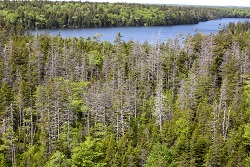
Disturbance & Succession
 The ecology of Nova Scotia has evolved and adapted to reflect the natural disturbance regimes that have shaped the province since glaciation. Disturbances, both large and small, change existing forest conditions and initiate succession to create dynamic new ecological communities. Nova Scotia's Code of Forest Practices outlines the principles of ecosystem-based management which focus on managing forest ecosystems to sustain their natural attributes by incorporating disturbance ecology into forest management planning. The adoption of ecosystem-based management enhances the ability to maintain natural successional and climax forests reflective of the Acadian Forest region.
The ecology of Nova Scotia has evolved and adapted to reflect the natural disturbance regimes that have shaped the province since glaciation. Disturbances, both large and small, change existing forest conditions and initiate succession to create dynamic new ecological communities. Nova Scotia's Code of Forest Practices outlines the principles of ecosystem-based management which focus on managing forest ecosystems to sustain their natural attributes by incorporating disturbance ecology into forest management planning. The adoption of ecosystem-based management enhances the ability to maintain natural successional and climax forests reflective of the Acadian Forest region.
Forest management planning and silviculture can be designed to simulate the frequency, intensity and scale of natural disturbance regimes, thus creating natural looking landscapes while conserving the structures and functions that native biodiversity has developed upon.
Forest disturbances lead to forest renewal and the development of forest habitats following characteristic patterns that reflect inherent ecosystem conditions. In order to provide guidance for more natural-based forest management a quantitative and spatial description of the natural disturbances, potential climax forests, and successional communities is required.
Links
Mapping Nova Scotia's Natural Disturbance Regimes
This report defines the natural disturbance regimes which have influenced forest development in Nova Scotia and documents the methodology used to map these using the provincial Ecological Land Classification. This report is now listed under publications and available to download.
Nova Scotia's Code of Forest Practice
A Framework for the Implementation of Sustainable Forest Management Guidelines for Crown Land
Impact of Hurricane Juan on woodlands and parks of central Nova Scotia
Research Reports
Wind Damage in Steamside Management Zones
A Pockwock-Bowater Watershed report documents blowdown following treatments in streamside buffers.
Selected Nova Scotia Old Growth Forests: Age, ecology, structure, scoring
Age class structure and physical attributes characterize four old growth Acadian forests.
Coastal Forest Communities of the Eastern Shore
Study of coastal old growth illustrates the natural structure and dynamics of Atlantic Boreal forests.
The Effects of Hurricane Juan on Managed Stands Commercially Thinned in Central Nova Scotia (November 2009)